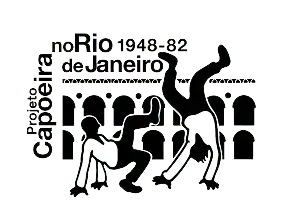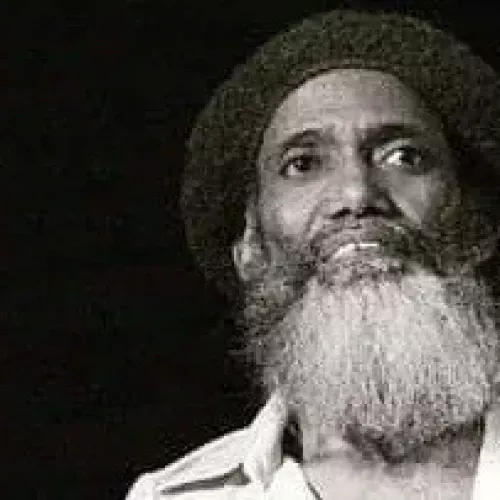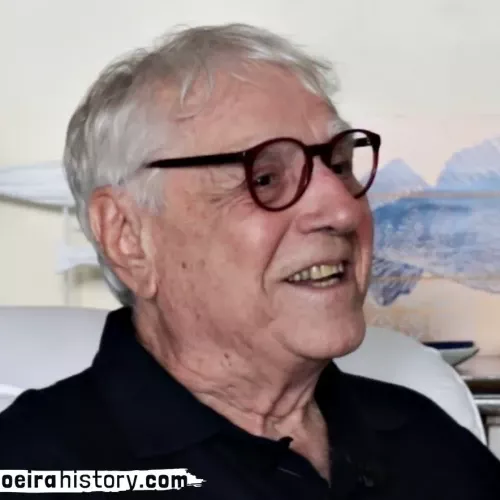José Tadeu Carneiro Cardoso, Master Camisa, was born in 1955, in Itapeipu, near Jacobina, in the backlands of Bahia, a region he would later recognise as a "melting pot of cultures". He started early in capoeira with Camisa Roxa, his older brother.
Lívia Pasqua and Renata Daflon.
It was this same brother who later, at the age of 12 or 13, took him to train with Mestre Bimba in Salvador. Still in Salvador, his talent in capoeira opened the doors of the Grupo Olodumaré, which staged folkloric shows of Bahian popular culture, with capoeira as the main attraction.
It was during a tour of the Olodumaré Group, in late 1972, that Camisinha (as he was also called initially, to distinguish him from his brother Camisa Roxa) arrived in Rio de Janeiro. He debuted in great style, with performances in concert halls and shows throughout the interior of the state. But the winds changed. Prevented from travelling with the company to Europe, because he was still an underage adolescent, Camisa gave up returning to Bahia. He reassessed the lost ties with his home region – the death of his parents, the absence of Mestre Bimba and the departure of his brother to Europe – and decides to try his luck in Rio de Janeiro, where, he was already “playing in all the capoeira rodas”.

In Rio, Mestre Camisa build up his professional network. Despite all kinds of difficulties, he managed to survive in the city, he combined his work in the world of shows with participation in the weekend rodas of the various groups in Rio, always based on the foundations learnt from the Bahian masters.
He joined the Grupo Senzala, becoming one of the masters of the group. His classes at the Civil Servants Association, next to the Canecão playhouse, attracted many students. In 1984 he organised a big event at the Circo Voador in Arpoador, with the participation of many of Bahia’s old masters, as well as capoeiristas from all over Brazil. In fact, this event contributed greatly to the spread of capoeira throughout Brazil and the interaction between teachers and mestres from other states.
In 1988, he left Senzala and some years later founded the Brazilian Association for the Support and Development of the Art of Capoeira (Abadá-Capoeira). Abadá is today one of the largest capoeira grouips in Brazil and in the world, with hundreds of associated groups or schools established in many countries.
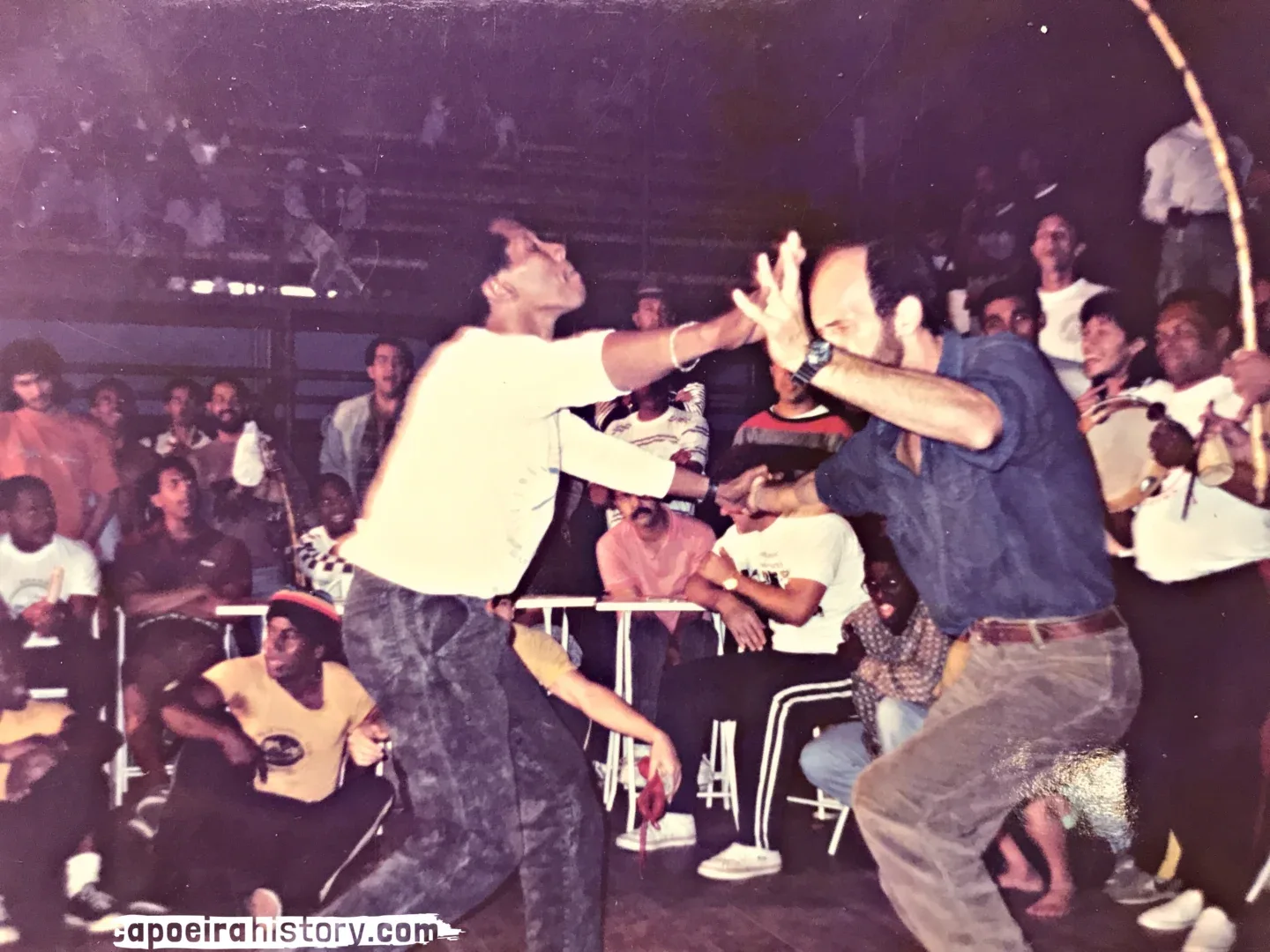

In the images: Masters Moraes and Camisa in the game. The event was the Rio World Samba Capoeira Meet, in 1984, which took place at Circo Voador, Lapa, Rio de Janeiro. Photos from the André Lacé collection.
And there is samba!
Mestre Camisa, as it was common amongst capoeiristas in the 1970s, also delved into the universe of samba in Rio de Janeiro. He already had the experience of samba from the Bahian interior and from the samba schools of Salvador. He then lived in Mangueira for more than ten years, socialising with sambistas, composing and parading in that famous samba school: “Then, when I arrived in Rio, I saw the samba of the samba schools, partido alto, these various types of samba. So that’s where I went deeper into the universe of samba. I compose samba, I have various sambas”. However, this was at the time when the storyline of the annual samba theme required the parading of capoeiristas. More recently, according to him, “samba moved away from capoeira”.
Mestre Camisa carries with him his Northeastern influences, with poetry, “cordel” literature and popular sayings, in the pursuit of valuing and preserving this cultural expression, affirming his commitment to safeguarding this intangible world cultural heritage through his practice, writing and teaching in a poetic and playful way (Mestre Camisa, 2015 and 2016; Trindade, 2017), as well as fostering new understandings and expressions about capoeira’s fields of action, such as its contribution to new berimbau rhythms and games (Trindade, 2022) and to the collaboration of an understanding of “floreio”(emberllishments of movements) in capoeira (Pasqua, 2022)
Capoeira and the pandemic
During the pandemic, the ABADÁ-Capoeira school went through challenges, transformations and technical adaptations, which led the mestre to reflect on his own way of interpreting and teaching this art. Thus, during this period, Mestre Camisa decided to formalize his style ─ Capoeira Abadá (with influences from Capoeira de rua, Capoeira Regional and Capoeira Angola).
During the pandemic period, the mestre created new berimbau rhythms, in addition to the characteristic Benguela (which already existed): São Bento da Abadá, Jogo Cruzado, Capopasso, Capoxadama, Gingalopante, Jogo do Pau, Silvestre and Siriúna, for example, which in turn influenced the way and characteristics of playing capoeira in the Abadá-Capoeira school. In the same way, rituals were revisited, such as the toque No pé do berimbau, which determines the moment to go to the foot of the berimbau in the game, as well as the rhythms that are used in capoeira.
You can learn much more about the evolution of capoeira in Rio de Janeiro by watching the CapoeiraHistory documentary "Entrevista com Mestre Camisa."
Interview given to Mestre Cobra Mansa and Dr. Matthias Röhrig Assunção on September 10, 2018.

Interview published in EntreRios Magazine, from the Federal University of Piauí
Read excerpts from the conversation with Mestre Cobra Mansa and Dr. Matthias Röhrig Assunção of the CapoeiraHistory.com team.
Lívia Pasqua (right) has a PhD in Physical Education from UNICAMP; professor at the School of Physical Education and Sports at UFRJ; coordinator of the Capoeira Laboratory at UFRJ; member of the Gymnastics Research and Experience Laboratory at UNICAMP. It also works with artistic performances; in addition to being coordinator of the artist collective Caleidoscope Brasil and Capoeira instructor of the group ABADÁ-Capoeira, since 2000.
Renata Daflon took a degree in Literature and is the deputy coordinator of the website capoeirahistory.com.
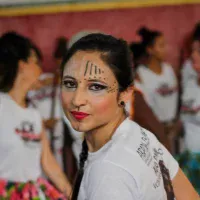
References
CARVALHO, Paulo César Valadares (Mestre Paulinho Velho). Escola Abadá-Capoeira: filosofia e método. In: MOREIRA, Sergio Rodrigues; OLIVEIRA, Sérgio Roberto de Lara; BRITO, Andreyson Calixto de (orgs.). – Petrolina, PE:UNIVASF; Fortaleza, CE: IFCE; Curitiba, PR: ABADÁ-Capoeira, 2020. V AbadÁcadêmico Capoeira, tecnologia e tradição: diálogos contemporâneos. Petrolina: UNIVASF, 2020.
MESTRE CAMISA. José Tadeu Carneiro Cardoso. Entrevista em 28/03/2023. Local: CEMB (Centro Educacional Mestre Bimba).
MESTRE CAMISA. José Tadeu Carneiro Cardoso. Versos, pensamentos, citações, provérbios, ditados, adágios, anexins, aforismos, máximas e ditos populares. Rio de Janeiro: Abadá edições, 2015.
MESTRE CAMISA. José Tadeu Carneiro Cardoso. Jogando com as palavras nas rodas da vida. Rio de Janeiro: Abadá edições, 2016.
MESTRE CAMISA. José Tadeu Carneiro Cardoso. Prefácio. In: Coletânea do VII AbadÁcadêmico – Escola Capoeira Abadá: Encontro Técnico-Científico de Capoeira [recurso eletrônico] / MOREIRA, Sergio Rodrigues; OLIVEIRA, Sérgio Roberto de Lara e BRITO, Andreyson Calixto de (orgs.). – Petrolina, PE: UNIVASF; Fortaleza, CE: IFCE; Curitiba, PR: ABADÁ-Capoeira, 2022, p. 4.
MESTRE CAMISA, José Tadeu Carneiro Cardoso. Jogos complementares da Capoeira Abadá: inovações para um melhor desenvolvimento do capoeirista. In: Coletânea do VII AbadÁcadêmico – Escola Capoeira Abadá: Encontro Técnico-Científico de Capoeira [recurso eletrônico] / MOREIRA, Sergio Rodrigues; OLIVEIRA, Sérgio Roberto de Lara e BRITO, Andreyson Calixto de (orgs.). – Petrolina, PE: UNIVASF; Fortaleza, CE: IFCE; Curitiba, PR: ABADÁ-Capoeira, 2022, p. 27 a 34.
PASQUA, Lívia de Paula Machado. A contribuição de Mestre Camisa para uma concepção de floreio na capoeira. In: Coletânea do VII AbadÁcadêmico – Escola Capoeira Abadá: Encontro Técnico-Científico de Capoeira [recurso eletrônico] / MOREIRA, Sergio Rodrigues; OLIVEIRA, Sérgio Roberto de Lara e BRITO, Andreyson Calixto de (orgs.). – Petrolina, PE: UNIVASF; Fortaleza, CE: IFCE; Curitiba, PR: ABADÁ-Capoeira, 2022, p. 115 a 125.
PASQUA, Lívia de Paula Machado; TOLEDO, Eliana de. Diálogos entre a capoeira e a arte: sobre um corpo polissêmico. Revista de Humanidades e Letras. Ceará, Brasil, vol. 7, nº. 2, p. 77-92, 2021.
SILVA, Valdinei Ribeiro. Mestre Camisa: Mosteiro de Jequitibá após 50 anos. In: SONODA-NUNES, Ricardo João; FREITAS, Jorge Luiz de; OLIVEIRA, Sérgio Roberto de Lara (orgs.). Anais do IV AbadÁcadêmico: Encontro Técnico-Científico de Capoeira. Curitiba: UFPR, 2019. p. 172.
TRINDADE, Francílio Benício Santos de Moraes. Mestre Camisa joga com as palavras na escrevivência da capoeira. In: MOREIRA, Sergio Rodrigues; SANTOS, Marcos Paulo Alves dos; NUMATA FILHO, Eduardo Seiji (orgs.). Anais do II AbadÁcadêmico: Encontro Técnico-Científico de Capoeira. Petrolina, PE: UNIVASF, 2017
TRINDADE, Francílio Benício Santos de Moraes. Capoeira Abadá, de Mestre Camisa: uma transformação e evolução da abadá-capoeira. In: Coletânea do VII AbadÁcadêmico – Escola Capoeira Abadá: Encontro Técnico-Científico de Capoeira [recurso eletrônico] / MOREIRA, Sergio Rodrigues; OLIVEIRA, Sérgio Roberto de Lara e BRITO, Andreyson Calixto de (orgs.). – Petrolina, PE: UNIVASF; Fortaleza, CE: IFCE; Curitiba, PR: ABADÁ-Capoeira, 2022, p. 172 a 183.
TRINDADE, Francílio Benício Santos de Moraes e OLIVEIRA, Marcos Vinícius Gomes de. Três Ciclos da ABADÁ-CAPOERA, de Mestre Camisa: memória e identidade de uma escola de capoeira. In: MOREIRA, Sergio Rodrigues; OLIVEIRA, Sérgio Roberto de Lara; BRITO, Andreyson Calixto de (orgs.). – Petrolina, PE:UNIVASF; Fortaleza, CE: IFCE; Curitiba, PR: ABADÁ-Capoeira, 2020. V AbadÁcadêmico Capoeira, tecnologia e tradição: diálogos contemporâneos. Petrolina: UNIVASF, 2020.
Lívia Pasqua é Doutora em Educação Física pela UNICAMP; professora da Escola de Educação Física e Desportos da UFRJ; coordenadora do Laboratório Capoeira da UFRJ; membro do Laboratório de Pesquisas e Experiências em Ginástica da UNICAMP. Atua também com performances artísticas; além de ser coordenadora do coletivo de artistas Caleidoscópio Brasil e instrutora de Capoeira do grupo ABADÁ-Capoeira, desde 2000.
Renata Daflon é formada em letras e é coordenadora adjunta do website capoeirahistory.com
